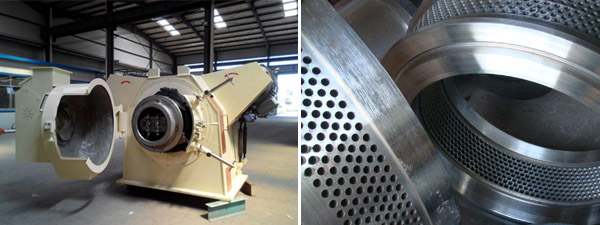How to choose the right ring die of pellet plant?
The price of ring die of pellet plant can be divided into stock cost, metal processing cost, drilling cost, heat treatment cost, fine reaming processing cost, management cost and profit. The price of the same kind of

material stock is essentially the same in different factories. The price for ring die with the thickness of under 45mm is basically the same. For large aperture ring die with the thickness of more than 45mm, material expense should be added. The scrap iron produced in metal processing can offset the processing fees. While the drilling cost is related to the amount of holes. Small aperture ring die has more holes that the drilling cost would be a little higher. The cost of heat treatment is determined by the weight of ring die. It is essentially the same for each manufacturer. Fine reaming processing cost is also related to the number of holes on the ring die, the price of small aperture ring die is a little higher. While the management cost varies, the bigger the factory, the lower the management cost. For profit, each manufacturer is different, some profits are 1-4 times higher than the cost of ring die, while some are reasonable.
Choose suitable compression ratio of ring die. Pellet produced by ring die with large compression ratio has large density and smooth surface. On the contrary, the pellet would be not strong enough with loose appearance, and this is also one of the causes of high powder content of pellet. The size of die hole and the compression ratio are mainly determined by user's formula and the varieties of feed. For the selection of compression ratio of ring die, due to various formula, different raw materials and granulating process, the appropriate compression ratio depends on the production experience of feed manufacturers in the production. An approximate range can be given based on past experience. Generally speaking, for livestock and poultry feed, the appropriate compression ratio should be 8 ~ 13; the appropriate compression ratio of fish feed is between 11 to 16. The appropriate compression ratio of shrimp feed is between 16 and 25. Heat sensitive feed should between 7 ~ 9 and forage and straw feed should between 5 to 7. Feed producers can adjust the aperture and compression ratio of ring die pellet mill according to the appearance of feed.
------------------------------------------------------------------------------------------------------------------------------------------------------
News
- How to make biomass pellets?
- What are the reasons for different length of biomass pellets?
- Easily blocked parts of biomass pellet machine should be cleaned regularly
- How to improve the die life of wood pellet mill?
- How to adjust the pellet length of wood pellet mill?
- Four tips for making high quality pellets with biomass pellet machine
- The factors affecting the production speed of biomass pellet machine
- The use and precautions of the ring die in wood pellet mill
- The structure and working principle of ring die pellet machine
- What's the reason for abnormal noise or sudden stop of biomass pellet machine?
- The production process of biomass pellet plant
- Pellet machine makes the pollution become resource
- What is biomass pellet fuel?
- How to distinguish the quality of accessories in pellet machine?
- The advantages and application of pellet machine
- Make biomass energy with pellet machine
- Ring die adjustment of sawdust pellet making machine
- The performance difference between flat die pellet machine and ring die pellet machine
- Does the weather change affect biomass pellet machine?
- An effective solution to output reduction of pellet machine
- Advantages of pellet machine
- Solutions to the appearance abnormality of pellet produced by pellet machine
- Five advantages of pellet machine
- How to make the service life of die in pellet mill longer?
- Matters needing attention in the application of pellet mill
